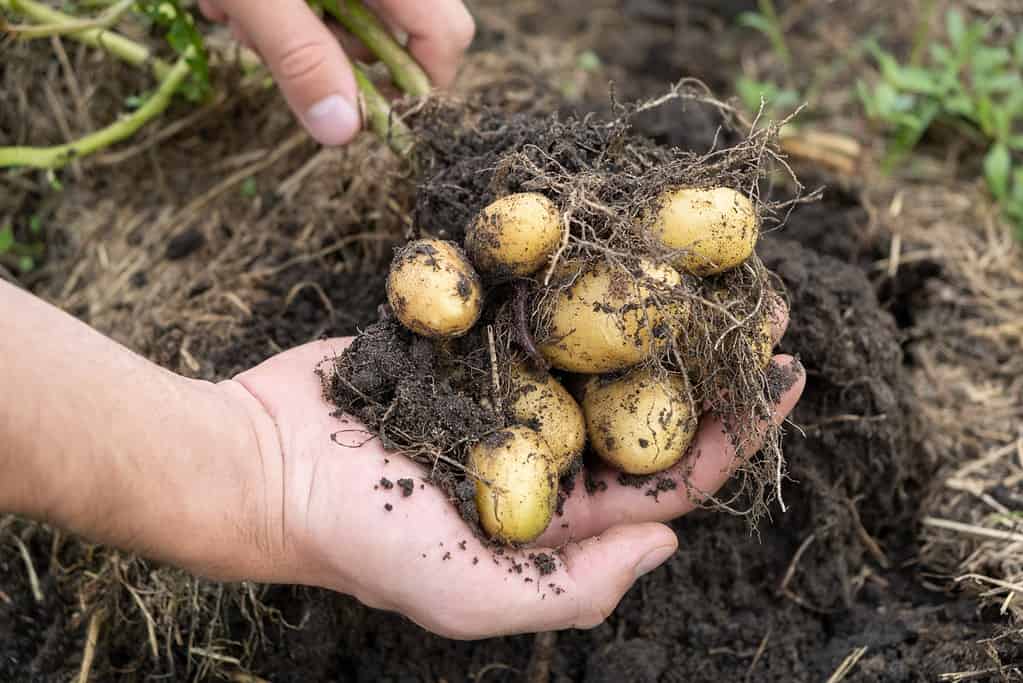Potatoes are a significant crop not only in Missouri but much of the United States. While this state isn’t considered to be a major producer of potatoes, there are several farms dedicated to potatoes. As a general rule of thumb, potatoes can be grown throughout Missouri. However, for commercial farming, there are two regions that are specifically best suited for growing potatoes in Missouri. This is the southeast and the northwest.
If you’re interested in growing your own potatoes in Missouri, then you may be wondering exactly where to get started. Below, learn more about how to grow potatoes in Missouri. Plus, explore some helpful tips!
Ideal Timing for Potatoes in Missouri

It is important to consider the weather when growing potatoes in Missouri.
©HannaTor/Shutterstock.com
When you are looking to learn more about growing potatoes in Missouri, it is important to learn more about potatoes in general first.
For instance, potatoes cannot survive frost or cold temperatures below 50 degrees Fahrenheit. As a result, if starting your potatoes inside, make sure not to bring them outside until such weather is no longer of concern. If planting directly into the ground, you’ll want to wait until this weather passes. Planting potatoes to avoid this weather involves a careful balance. This is because planting too early will leave your potatoes vulnerable in the spring while planting too late can leave them vulnerable to the first frost come fall.
If you are growing your potatoes from seeds, it can take up to around 40 days for your potatoes to be ready for outside. Seed potatoes can be prepared properly and planted directly into the ground.
Overall, the best time to plant potatoes in Missouri is in the middle of spring, usually around April. It is important to wait for the soil to warm up after a winter of cold weather. You’ll also need to make sure that the days of frost and cold temperatures are behind you. Potatoes require full sun and well-drained soil, so make sure to keep these factors in mind when planting your potatoes outside.
Tips for Growing Potatoes

There are several ways to help improve your chances for a successful potato harvest in Missouri.
©FotoDuets/Shutterstock.com
Now that you know more about growing potatoes in Missouri, including the ideal timing, you may be interested in learning some helpful tips. These tips can help you make the most out of your potato harvest.
Continue reading below for some helpful potato-growing tips!
Choose Certified Seed Potatoes
As a root vegetable, potatoes are unique from many other common crops in the world. This is because it is possible to grow potatoes from other potatoes. If you have kept a potato for too long in your cabinet, you may have noticed it beginning to sprout. When planted, a potato will produce a plant, which will then produce more potatoes.
However, if you are looking to grow your potatoes this way and not from a seed, you will need to be careful with what types of potatoes you choose. It is always best to choose potatoes that are certified seed potatoes. These are potatoes sold with the intention of being planted to receive more potatoes.
While you can grow potato plants with potatoes purchased at the grocery store, this is not always ideal. This is because many grocery stores or places selling potatoes as edible produce spray these vegetables with sprout-retardent. This will prevent or dampen the potato’s ability to grow.
Avoid Hilling By Planting Potatoes Deeper

Potatoes need dark places to grow.
©ArieStudio/Shutterstock.com
When you plant a potato, you need to ensure that they are always in complete darkness. This is done by hilling, in which the soil is formed into a small hill at the base of the plant to help it grow. However, hilling is not the only way to help your potato plants grow.
If you do not want to hill your potato plants, or you are unable to, you can solve this problem by planting your potatoes deeper in the ground, usually up to several feet deep. However, if you use this method, you may end up with smaller yields and smaller potatoes.
Increase Space Between Crops for Easier Weeding
One of the most important things in any garden is weeding. While nearby flowers and plants can help draw helpful pollinators to your garden, weeds growing around your plants can take away important resources. This includes water, nutrients, and sunlight. As a result, it is important to weed your garden often.
In order to make this process easier, you may wish to consider planting your potatoes with a greater distance between each plant, around two feet each. Although this takes up much more space than close sowing, it will provide you with more space to tend to your plants. This includes more space to weed.
The photo featured at the top of this post is © Kristi Blokhin/Shutterstock.com
Thank you for reading! Have some feedback for us? Contact the AZ Animals editorial team.







